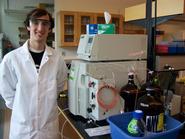
Piscidins are potent biological substances. Classified as antimicrobial peptides, they naturally fight off infection in organisms like the hybrid striped bass, among others. There are four members of the family of piscidins that Billy Wieczorek ’11 is studying this summer. Piscidin-1 has been the subject of myriad other studies, and although it has many antimicrobial properties, it can be harmful to human blood cells because it cannot differentiate between bacterial and mammalian cells.
Piscidin-3, on the other hand, is less dangerous, and might be able to attain some of Piscidin-1’s advantageous qualities. Wieczorek is working with Associate Professor of Chemistry Myriam Cotten to understand Piscidin-3’s structure and how that might help them alter Piscidin-3’s abilities.
Wieczorek is a fan of metaphors and likes to apply them to his research whenever he can. For instance, he and Cotten want to observe Piscidin-3’s interaction with the bacterial cell membrane – he compares this to a ripped piece of paper. If he does not let anyone see how he rips it, no one can understand the nature of that interaction. Onlookers do not know whether he used scissors or shredded it with his bare hands. In the same way, Wieczorek and Cotten need to know how the peptide penetrates the membrane. They will use solid-state NMR (nuclear magnetic resonance) to do this. “Most undergrads never get to see this kind of machine,” Wieczorek noted.
They are also calculating the angle at which the peptide plunges into the membrane. Wieczorek suggests that non-chemists imagine a taut sheet of plastic wrap. If you poke even a few holes in it, the whole sheet will eventually tear. At the chemical level, the peptide’s angle on the surface contributes to how easily the membrane will give way to it. This too requires solid-state NMR technology.
Wieczorek’s research is dissimilar to other chemistry projects in that it involves many mathematical simulations and manipulation of data. Each of the variables Wieczorek is using to measuring through solid-state NMR has a specific equation to define it, and two of these are tau and rho. They represent, respectively, the tilt angle and the rotation of the peptide about its axis. When his plots these equations, they appear as a sine or a cosine wave, and Wieczorek’s job is to alter tau and rho in the equations to make them fit the data he has already collected. To do all of this, he uses a program called MATLAB, which was written by one of Cotten’s former graduate students. The program offers supreme flexibility and power in data analysis.
Wieczorek is a chemistry major who plans on completing the rigorous dual degree for a medical doctorate and a Ph.D. after Hamilton. His research this summer will provide a baseline for his potential post-graduate work in non-profit pharmaceuticals. “In high school I was really into math and science,” he said. “I really loved how they help you understand phenomena. Like the atomic theory – it amazes me that people actually came up with that, and it was right! To me, that’s thrilling.”
Wieczorek is a graduate of Amherst Central High School
Piscidin-3, on the other hand, is less dangerous, and might be able to attain some of Piscidin-1’s advantageous qualities. Wieczorek is working with Associate Professor of Chemistry Myriam Cotten to understand Piscidin-3’s structure and how that might help them alter Piscidin-3’s abilities.
Wieczorek is a fan of metaphors and likes to apply them to his research whenever he can. For instance, he and Cotten want to observe Piscidin-3’s interaction with the bacterial cell membrane – he compares this to a ripped piece of paper. If he does not let anyone see how he rips it, no one can understand the nature of that interaction. Onlookers do not know whether he used scissors or shredded it with his bare hands. In the same way, Wieczorek and Cotten need to know how the peptide penetrates the membrane. They will use solid-state NMR (nuclear magnetic resonance) to do this. “Most undergrads never get to see this kind of machine,” Wieczorek noted.
They are also calculating the angle at which the peptide plunges into the membrane. Wieczorek suggests that non-chemists imagine a taut sheet of plastic wrap. If you poke even a few holes in it, the whole sheet will eventually tear. At the chemical level, the peptide’s angle on the surface contributes to how easily the membrane will give way to it. This too requires solid-state NMR technology.
Wieczorek’s research is dissimilar to other chemistry projects in that it involves many mathematical simulations and manipulation of data. Each of the variables Wieczorek is using to measuring through solid-state NMR has a specific equation to define it, and two of these are tau and rho. They represent, respectively, the tilt angle and the rotation of the peptide about its axis. When his plots these equations, they appear as a sine or a cosine wave, and Wieczorek’s job is to alter tau and rho in the equations to make them fit the data he has already collected. To do all of this, he uses a program called MATLAB, which was written by one of Cotten’s former graduate students. The program offers supreme flexibility and power in data analysis.
Wieczorek is a chemistry major who plans on completing the rigorous dual degree for a medical doctorate and a Ph.D. after Hamilton. His research this summer will provide a baseline for his potential post-graduate work in non-profit pharmaceuticals. “In high school I was really into math and science,” he said. “I really loved how they help you understand phenomena. Like the atomic theory – it amazes me that people actually came up with that, and it was right! To me, that’s thrilling.”
Wieczorek is a graduate of Amherst Central High School
Posted August 17, 2009
